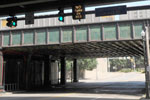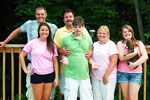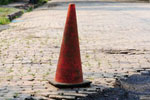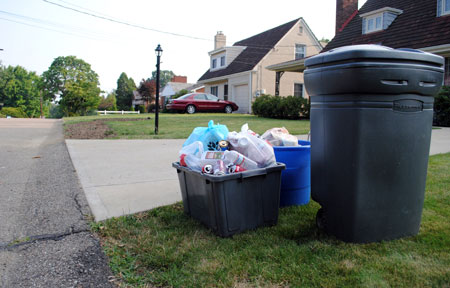
Category Archive: Legislative / Advocacy
-
Children’s Museum Has Plans to Beautify Unsightly Underpasses
By Bill Zlatos
PITTSBURGH TRIBUNE-REVIEW
Monday, July 12, 2010
Underpass Artwork: The Norfolk & Southern Railroad underpass at Federal Street on the North Side has been proposed to be a public space gallery featuring murals and other artwork. Philip G. Pavely | Tribune-Review
Visitors from Downtown to the North Side must now pass through a dark maze of cold, concrete underpasses. But the Children’s Museum of Pittsburgh will soon inject it with a bit of brightness.
The museum is working with Norfolk & Southern Railroad and other groups to convert the railroad’s underpass on Federal Street near the post office into an outdoor art gallery. Work will start this fall and be finished in about a year.
“The underpasses have long been a blighted barrier between the neighborhoods of the North Side and the amenities of the North Shore,” said Mark Fatla, executive director of the Northside Leadership Conference.
The conference is working with the Urban Redevelopment Authority on another project to improve underpasses on Anderson and Sandusky streets. That involves new sidewalks, curbs and crosswalks.
The gallery project involves cleaning and painting the Federal Street underpass, and installing lights and a metal mesh where works of art can be hung. The new color of the bridge and its columns has not been determined.
“These railroad bridges and underpasses kind of contribute to that sense of inaccessibility and remoteness,” said Christopher Seifert, deputy director of the Children’s Museum. “The idea is to celebrate that entry, celebrate the bridges. We’ll use art to enhance the neighborhood spirit.”
The underpass gallery is part of the Charm Bracelet Project, which has encouraged two dozen North Side groups to work together. Among the Charm’s activities is free kayaking lessons on Lake Elizabeth with Venture Outdoors.
The cost of the gallery is estimated at $300,000. The main contributors are The Heinz Endowments, NRG Energy Co., the Grable Foundation and the National Endowment for the Arts.
“We imagine an individual artist with a regional or national reputation could do a one-person show,” Seifert said. “We could have a curated show from a half dozen artists or art from kids.”
Representatives from North Side groups will curate and coordinate the gallery project.
Fatla said some North Side residents hope that the underpass projects will draw visitors to their neighborhoods.
“I don’t think it will bring tons of customers to the near-North Shore neighborhoods,” he said. Rather, he continued, “If you buy a house here, you have a lovely pleasant walk to the ballpark, the riverfront trail or Downtown. It improves the value of living here.”
-
Grant For Shower Fix ‘A Blessing’ to West Deer Family
By Jodi Weigand
PITTSBURGH TRIBUNE-REVIEW
Thursday, July 8, 2010
A new grant program for the disabled will help the Wilczynski family of West Deer transform its traditional bathtub into a walk-in shower with a bench and safety rails for family member Austin, 16, who has multiple disabilities, including cerebral palsy. The family plans to use $1,500 from the New Story Fund to make the improvements this summer. Members of the Wilczynski family: Back row, from left: Victor (Jr.) and Victor (Sr.) Front row, from left: Amanda, Austin, Bonnie and Samantha. Submitted
A new grant program for the disabled will help a West Deer family transform its traditional bathtub into a walk-in shower with a bench and safety rails.
Bonnie Wilczynski said the family’s shower is too small and a little bit scary for her son, Austin, 16, who has multiple disabilities, including cerebral palsy. He has trouble getting in and out of the tub and has slipped a couple of times, she said.
The family plans to use $1,500 from the New Story Fund to make the improvements this summer. Without the money, the most they could have done was attach a few safety rails, said Wilczynski, 49.
“Hopefully, this new shower will be large enough to move around, and it won’t be so slippery,” she said.
The Wilczynskis are among 23 Pennsylvania families to be the first to benefit from the New Story Fund, a part of New Story, a for-profit company that operates 10 schools and 17 program and services facilities across Pennsylvania for children with serious or complex disabilities. The fund, announced in February, will award up to $25,000 twice a year to Pennsylvania families, with a $1,500 maximum per family.
An affiliation with New Story is not required and grants are available to children with any type of disability, including emotional, behavioral or educational.
“The application was so easy to fill out (because) I didn’t have to have six doctors’ notes and health insurance denials,” Wilczynski said. “Anytime you try to do anything, even simple things, it’s such a hassle. … So something like this is such a blessing.”
That was the idea behind the New Story Fund, said Tara Koretz, the company’s director of development.
“Tell us your story, tell us your need, so that we can help you,” she said. “It’s not an amount of money that’s going to pay for college or buy a new home, but it’s that piece of something that gives families that little bit to be able to breathe and enjoy their family time.”
Other families received money to pay for doctor’s visits, build a safety fence and buy orthopedic shoes, Koretz said.
To get help
The New Story Fund is accepting nominations for its second round of grants through Aug. 31 at www.newstory.com/about/the-new-story-fund.php.
-
Fight On to Keep Brick Street in Regent Square
By Alyssa Karas
PITTSBURGH TRIBUNE-REVIEW
Wednesday, July 7, 2010
Signs posted along Macon Avenue in Regent Square detail the residents' fight to keep their brick roads from being paved over by the water company. Andrew Russell | Tribune-Review
The clusters of bright orange cones on Macon Avenue in Regent Square alert motorists and pedestrians of giant holes in the yellow-brick road.
But the cones are warning signs of a battle brewing between Swissvale residents and a water company.
When Wilkinsburg-Penn Joint Water Authority replaces the water line in the 1400 block of Macon Avenue, the company intends to remove the bricks then pave the street with asphalt. But many residents are adamant that the brick street be restored, and plan to protest the water authority’s decision at the council meeting at 7 p.m. today.
“It will be a fight (with water authority officials) if it has to be,” said Swissvale Borough Council President David Petrarca. “(Residents) want brick. They do not want asphalt. It’s always that way.”
Much of the debate centers on cost. Petrarca said water authority officials put an estimated $270,000 price tag on the project. This includes removing the brick, replacing the main water line and all lateral lines to homes, putting down a new base then paving with asphalt.
The water authority did not provide an estimate for replacing the bricks on the nearly 100-year-old streets, Petrarca said. Brick would be more expensive in the short-run but require less maintenance over time, borough officials said. Water authority Manager Anthony Russo Jr. declined to comment.
The water authority may run into some legal roadblocks. According to Swissvale Solicitor Bob McTiernan, the borough has an ordinance that states materials used to replace a street surface must be of the same covering and the same grade as the originals.
Residents and council members said the bricks keep property values up, make the streets safer and add to the neighborhood’s charm.
“I love this neighborhood,” said resident Ann Walston, 62. “One of the most beautiful things about it is the streets and the trees.”
The issue began after a water main break on June 22 caused sinkholes to cave in. When at least one sinkhole was patched with asphalt, residents took notice, Webber said. Residents began organizing meetings and writing letters to council members and the mayor.
Other communities are facing similar problems. In Aspinwall, Borough Manager Ed Warchol has grappled with what to do about a worn-out brick road for more than a year.
“The problem is the expense,” Warchol said. “It’s astronomical. It keeps the quaintness of everything, but I don’t have the money.” However, it’s important to keep in mind what the community wants, he said.
Arthur Ziegler, president of Pittsburgh History & Landmarks Foundation, said the Regent Square streets could qualify for landmark status. A structure must be at least 50 years old and designed with distinction, Ziegler said.
“I just hope they find a way to keep these bricks that contribute to the uniqueness of this marvelous neighborhood,” he said.
-
URA Moves to Subsidize Several Developments in Pittsburgh
Friday, July 09, 2010Pittsburgh Post-GazetteThe city’s Urban Redevelopment Authority board Thursday made early moves to subsidize developments in the Strip District, Squirrel Hill and the South Side and sold properties to make way for an expanded YMCA in the Hill District.
The subsidies it preliminarily approved were tax increment financing (TIF) plans to support building public infrastructure at: a mixed-use, commercial and residential redevelopment of the lower Strip District between 11th and 21st streets, near the URA-owned Produce Terminal; and a third phase of redevelopment of the former Nine Mile Run slag heap into housing units at the Summerset at Frick Park, extending the development site toward Swisshelm Park. No development costs, designs or timetables were released for either project, as they are still in early planning stages and the board’s action was merely the first of many moves necessary to approve the tax subsidies.
The URA board also approved extending a TIF plan originally approved in 1999 for the SouthSide Works, expanding the money available for infrastructure from $25 million to $35 million, in order to help pay for a new parking garage at the former brownfield site and new riverfront park improvements. Like the other TIF measures, it also needs approvals by the city’s three local taxing bodies — the city, the county and Pittsburgh Public Schools.
The YMCA plans to break ground by September for the expansion of its athletic facilities on Centre Avenue, with the help of 18 adjacent lots controlled by the URA. The expanded building — with the goal of being finished by the end of 2011 — would include an indoor swimming pool, gymnasium, health center, computer lab and other facilities.
-
Hill Innovation Center Gets State Funds
Thursday, July 08, 2010By Joe Smydo, Pittsburgh Post-Gazette
Surrounded by members of the Urban Redevelopment Committe and the Pittsburgh Gateways Corporation, Gov. Ed Rendell signs the economic development portion of the 2010-11 state budget to help create jobs.
Gov. Ed Rendell on Wednesday announced up to $8 million in state funding for a green innovation center in the Lower Hill District that may begin operations by fall.
Pittsburgh Green Innovators — to be housed in the former Connelley vocational-technical school — will be a home for new companies and training programs with an environmental theme.
In a sign of the project’s importance, Mr. Rendell traveled to the location to announce the funding for that project and sign the legislation creating the $600 million development fund, called the Redevelopment Assistance Capital Program.
“Pittsburgh has probably transformed itself more than any other American city, and that transformation is ongoing. It doesn’t stop. Green energy is the way of the future,” he said.
In all, about $300 million of the money already has been earmarked for projects statewide.
That includes the $8 million for Pittsburgh Green Innovators and up to $30 million to lure a federal vaccine production center to Allegheny County. The center, proposed by the University of Pittsburgh Medical Center, would produce vaccines needed to defend against biological attacks.
Recipients of the state money must match it dollar-for-dollar with funds from other sources.
Pittsburgh Gateways, a Lawrenceville economic-development group that’s spearheading the green innovation center, is negotiating with Pittsburgh Public Schools to acquire the 300,0000-square-foot former Connelley building. Robert Meeder, president of Pittsburgh Gateways, said he hopes to close on the deal as early as September.
He said the first phase of renovations — focusing on 80,000 square feet but including the installation of environmentally friendly energy systems throughout the building — could begin in the first half of 2011. He said that work will cost about $26 million, while a later phase of renovations, covering the rest of the building, would cost an estimated $19 million more.
Officials have said public school classes, apprenticeship programs and college classes all would be offered at the center, allowing students to train for careers with an environmental focus.
In a sense, the building — employing solar, geothermal and other alternative energies — will be a giant classroom, Dr. Meeder said.
The first classes may begin in the fall, he said.
The building also will serve as an incubator for start-up businesses. Dr. Meeder said as many as 14 fledging companies may have space there by the end of 2011.
State Sen. Jim Ferlo, D-Highland Park, an early proponent of the project, said the center already received $4 million from a previous pot of Redevelopment Assistance Capital Program dollars. The project also has received about $2 million in federal aid, and Dr. Meeder hopes to lure $7 million from corporate and foundation sponsors.
-
Allegheny County Communities Examine Benefits of Recycling More
By Daveen Rae Kurutz
PITTSBURGH TRIBUNE-REVIEW
Thursday, July 8, 2010
Talkin trash. Ross officials are kicking off a recycling campaign to encourage residents to be more recycle friendly. Residents on Jefferson Street in the North Hills Estates are taking part in the recycling efforts. Samantha Cuddy | Pittsburgh Tribune-Review
Communities across Allegheny County are lightening their loads.
Instead of throwing away such items as newspapers and plastic bottles, more residents are recycling them.
Mt. Lebanon is recycling at nearly double the rate of just two years ago.
“There are so many environmental benefits. It makes sense to recycle,” said Larry Holley, manager of the Division of Waste Minimization and Planning with the state Department of Environmental Protection. In Pennsylvania, the “green” benefits extend beyond the environment.
DEP reimburses municipalities for what they recycle — disbursing nearly $35 million last year, Holley said.
Mt. Lebanon officials sold their constituents on recycling by making it easier for them to do. Last year, the township began allowing residents to toss all recyclables in one bin. Tom Kelley, director of public works, said Waste Management has collected 1,056 tons of recyclables so far this year – an 88 percent increase from the same time in 2008.
“It’s an easy program, and people like that,” Kelley said. “When you make things easy for people, they’re going to participate.”
Last month, Ross agreed to a one-year contract extension with Waste Management.
Mike Christ, municipal coordinator for the company, told township officials that they could double the amount of materials recycled if they increased awareness of what can be recycled.
“People don’t realize how much can be recycled,” Christ said. “They still think newspapers can’t be thrown in there.”
A heavy load
Pennsylvanians recycle about 5.2 million tons of garbage each year, according to the DEP.
The 5.2 million tons of recyclables saved 55,500 acres of standing forest and reduced greenhouse-gas emissions equal to removing 1.4 million vehicles from the roads, Holley said. He estimates that nearly 80 percent of all Pennsylvanians have access to some sort of recycling program.
Ross Commissioner Pete Ferraro said he believes recycling could help the township with its budget problems.
In December, Ross officials passed a 2010 budget that includes $1.3 million worth of cuts. Ferraro said he wants to at least double the township’s recycling reimbursement from the state – which totaled more than $22,000 last year.
“If we can raise $25,000 above and beyond our normal revenues, that’s a police car for us,” Ferraro said. “It’s worthwhile for our residents to recycle.”
In Robinson, the township began offering residents the opportunity to put all their recyclables in one bin this year. Township Manager Aaron Bibro said he receives several calls each month about recycling and believes that residents are catching on.
“The township just wants to do its part in creating a green community,” he said.
-
A Newsmaker You Should Know: Historical Society Chief Links Past to Present
Thursday, July 08, 2010Marilyn Albitz barely passed high school history — a close call she attributes to a teacher who she said wanted her students only to memorize dates.
“I was an A student, but [historical] dates always turned me off. Rather, I’ve always liked to hear stories about the people, what they did, where they came from,” Ms. Albitz recalled.
MARILYN ALBITZAGE: “I’m a senior citizen, that’s all I’ll admit.”
OCCUPATION: Community volunteer
EDUCATION: Dormont High School
FAMILY: Husband, Robert; three children; seven grandchildren
WHAT’S IMPORTANT TO YOU? “My family and my borough’s history.”
PEOPLE WOULD BE SURPRISED TO KNOW: “I was once very shy. Now all I do is talk.”
FIRST JOB: Office supervisor at Prudential Insurance
HOBBIES: Reading and traveling
READING MATERIAL ON YOUR NIGHTSTAND: Romance novels and trivia books
WHAT’S PLAYING ON YOUR TV: “The Mentalist,” “The Good Wife,” “NCIS: Los Angeles,” “Jeopardy!”
GUILTY PLEASURE: Chocolate candy
FAVORITE SPOT IN THE WORLD: Green Tree. “There’s no place like here.”
MOST EMBARRASSING MOMENT: “I’m sure there have been plenty, but I can’t think of any to share now.”
PROUDEST MOMENT SO FAR: “I’m proud of my family. And I was very proud being invited to Harrisburg.”
Now, as Green Tree Historical Society president, she is learning history the way she likes it: stories of the people who have lived in her community and the surrounding area.
“People influence other people. Our history is like a puzzle, and with each story, you get another piece,” she said.
Ms. Albitz credits former Green Tree librarian Roberta Antin as her greatest influence.
“She took me under her wing,” Ms. Albitz said. “She was our historian before we had the historical society. She collected stories, photos, newspapers, everything she could.”
Ms. Albitz started Green Tree’s historical society 25 years ago and has since helped other local communities start theirs, including Brentwood, Carnegie, Crafton, Dormont, Ingram, Mt. Lebanon and Reserve.
“I’d just take a folder of information and go talk to people about what we do and how we did it,” she said.
She wanted to help other communities start their historical societies for the same reason she wanted to start Green Tree’s.
“It’s important for you to know what your community is and was and where it’s going,” she said. “It’s important to collect more than Green Tree’s history because all these communities were once connected.”
State Rep. Matt Smith, D-Mt. Lebanon, hosted Ms. Albitz in Harrisburg last month to recognize her efforts in organizing Green Tree’s 125th anniversary celebration.
“[Ms. Albitz] herself is a community treasure. She is truly the kind of person that makes Green Tree and surrounding communities so special,” he said.
Mr. Smith was a history major at Rollins College and said there was “a huge advantage to preserving each community’s heritage. [Ms. Albitz] does a great job preserving that history.”
But talking to groups interested in forming their own historical society wasn’t easy for Ms. Albitz decades ago.
“I was so shy,” she said. “I took a public speaking class at the community college to help me get past that.”
During the class, she learned a lesson that she still relies on today.
“Just be yourself. You know more about what you’re talking about than the people you’re telling it to,” she said.
A lot of people have benefited from the information Ms. Albitz has shared and she’s been “very valuable to the community,” according to Dave Montz, Green Tree manager.
“People have been able to trace their roots, and she’s worked with children, too. They’ve learned where they live wasn’t always a traffic-congested, busy town. It was actually once farmland,” he said.
Ms. Albitz said she was a natural organizer growing up in Dormont with three brothers and one sister.
Later, she worked as an office supervisor for 13 years at Prudential Financial Inc. in Kennedy before starting a family. She has three children — David, Linda and Jeffrey — and seven grandchildren, ranging in age from 2 to 22.
As a mother, she served as a leader in the school’s Parent Faculty Organization.
In addition to her leadership in Green Tree’s historical society, she is president of the borough’s seniors’ club and belongs to its women’s club.
“People tell me I do too much and that I should learn to say ‘no.’ But you can’t say ‘no’ to stuff that interests you,” she said.
Reading is another of Ms. Albitz’s interests.
“I love romance novels. So many of them take place in different countries, and I love those settings. I skim over most of the romance. At my age, who cares?” she asked with a laugh.
Ms. Albitz does not disclose her age but did offer that she was married in 1953 to her husband, Robert, at St. Bernard Church in Mt. Lebanon.
“Compromise is the key,” she said of her nearly 60-year marriage. She also joked that it might help that she’s rarely home because of her work with social groups and traveling with the seniors’ club.
“I’m not home much, but I love to bake when I am,” she said.
Her favorite recipe is for her mother’s pumpkin pie, and she also likes to bake cookies.
“Grandma always has a can of cookies in her freezer,” she said.
She would spend more time baking if she had the time, she said, but there’s still too much to be done at the historical society.
“I’ve got to find someone to take this over after I’m gone,” she said. “I thought I’d retire this year, but I can’t. I’m still learning too many new stories.”
-
Ambridge Redevelopment Receives $5 Million
Thursday, July 08, 2010By Brian David, Pittsburgh Post-GazetteDuring his first term, Gov. Ed Rendell visited Ambridge and pledged to support an ambitious redevelopment project in the town’s northern end.
With his second term winding to an end, the governor included $5 million toward the redevelopment in a $600 million list of capital projects he signed Wednesday at Connelley Technical School in Downtown Pittsburgh.
“He’s holding true to his word,” state Rep. Rob Matzie, D-Ambridge, said Wednesday. “This last appropriation in his term should help put the project over the hump.”
The $5 million requires a one-to-one match in local funds, Mr. Matzie said. “It’s not free money,” he said.
The Northern Ambridge Redevelopment Project is a public-private partnership inspired by Australian tycoon Rob Moltoni.
It already has established the New Economy Business Park, is in the process of straightening Merchant Street, has provided a new home for the Beaver County Emergency Services Center and is still clearing old industrial land for additional uses.
The project has received about $4 million in state funding over the years.
Overall, the project is a showpiece for the potential of public-private partnership, he said.
Without public help, it would have been impossible to clear the old industrial buildings from the project’s 22-square-block footprint; with it, the project is providing usable space in the heart of town adjacent to the historic district around Old Economy Village.
“It’s very important for the naysayers, the people who say government shouldn’t be involved,” Mr. Matzie said. “This shows that cleanup can occur, and you can revive your town.”
